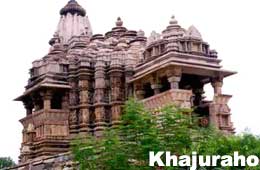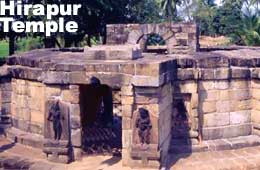| India Profile » Monuments and Temples in India » Yogini Temples, Orissa | |
Yogini Temples, Orissa | |
 | |
 Orissa has the distinction of preserving two of the outstanding temples of goddess Yogini, one at Hirapur, a village near Bhubaneswar and another at Ranipur-Jharial in Bolangir district. The temple was built in the 9th century AD and is the center of Tantricism and Shakti even till today. The Bhauma and Somavamsis rulers of Orissa built the Yogini temples. There was a gradual amalgamation of Shaivism, Shaktism and Avajrayana form of Mahayana Buddhism during this period in this region. There are nine Chausanth Yogini temples in India out of which the best kept are at Jabalpur and Khajuraho in Madhya Pradesh, Uttar Pradesh and Tamil Nadu. They were built between 9th and 13th centuries AD. The Yoginis were considered to be able to confer their devotees with the power to become small or gigantic in size, to control one's body and mind of others, to fly, become invisible, and infinite other useful abilities. The devotees repeated the names of the Goddesses. In the subsequent centuries, when the active use of the shrines reduced, worshippers shifted their venerations to occult paper diagrams. The growth of Yogini cult can be traced to the rural and tribal form of worship. The goddess Yogini derived its form from the local village goddess or the gram devi. The entire development of Yogini worship and the construction of temples are derived from outside the confines of orthodox Brahmanical tradition. The Yogini came into existence in the 7th-8th century AD in the shape of a Sakta-Tantric cult. It continued to flourish as an important manifestation of Shakta Tantricism. In the villages of India, especially in Orissa, each village has a favored deity. Each gram devi, like Ramchandi, Shyamkali, Harachandi, Tarini, Viraja, Bhagavati, Durgamata, Sarala, Bhadrakali, Kamakhya, Bhabani, Mangala, all presides over the well-being of the village. These village goddesses seem to have been gradually transformed and consolidated into potent numerical groupings of sixty-four acquiring thereby a totally different character. The remains of Yogini temples in various parts of the country clearly reveal that the exponents and followers of this esoteric cult made vigorous attempts to popularize it and this cult was of impelling and vital significance from the 9th to the 12th century. The Yogini temple at Ranipur-Jharial has a circular wall, which is just 2 meters high and contains 64 niches within its inner perimeter. All the niches except one contain an image of the Goddess Yogini. Some of the idols are depicted with sensual bodies and ornamented bodices. Some others have horrific shrunken features and a few others with animal heads. The temple was worshipped between 9th to 13th century AD in expectation of acquiring supernatural powers by the goddess.
The sculptures of Hirapur temple are inordinately graceful. Faces are exquisitely carved often depicting a gentle smile and with hair style of various styles and heavily ornamented. The architecture of this temple blends a extremely original sculptural tradition with extraordinary workmanship. |
|
 |
 The Yogini temple at Hirapur was probably built towards the end of the Bhauma rule, i.e., 9th century AD, as the sculptures strongly resemble those of the famous Mukteshwar temple of Bhubaneswar, which was erected in the 9th century. The Hirapur temple is the smallest among all the Yogini temples and measures 30 ft in diameter with stonewalls barely eight feet high. It is built of coarse sandstone blocks with laterite in foundation. The Yoginis are carved from fine-grained gray chlorite. The inner walls of the temple have sixty-four niches with sixty Yoginis still in position. It is the only temple, which has sculptures on its outer walls. We can see nine niches each containing a female figure made of sandstone. Each figure stands upon a large severed human head, holding a curved knife or javelin in one hand and a skull cup in the other. The entrance of the temple is unusual as it has a projecting entrance way flanked by doorkeepers. There is a skeletal male of fearsome presence on either side of the narrow vestibule. He is wearing a garland of skulls and snake anklets with one figure holding a severed human head. On the pedestal below are two more similar skeletal figures holding skullcaps and jackals beside them.
The Yogini temple at Hirapur was probably built towards the end of the Bhauma rule, i.e., 9th century AD, as the sculptures strongly resemble those of the famous Mukteshwar temple of Bhubaneswar, which was erected in the 9th century. The Hirapur temple is the smallest among all the Yogini temples and measures 30 ft in diameter with stonewalls barely eight feet high. It is built of coarse sandstone blocks with laterite in foundation. The Yoginis are carved from fine-grained gray chlorite. The inner walls of the temple have sixty-four niches with sixty Yoginis still in position. It is the only temple, which has sculptures on its outer walls. We can see nine niches each containing a female figure made of sandstone. Each figure stands upon a large severed human head, holding a curved knife or javelin in one hand and a skull cup in the other. The entrance of the temple is unusual as it has a projecting entrance way flanked by doorkeepers. There is a skeletal male of fearsome presence on either side of the narrow vestibule. He is wearing a garland of skulls and snake anklets with one figure holding a severed human head. On the pedestal below are two more similar skeletal figures holding skullcaps and jackals beside them.